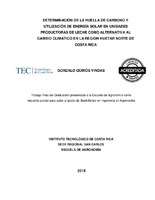Mostrar el registro sencillo del ítem
Determinación de la huella de carbono y utilización de energía solar en unidades productoras de leche como alternativa al cambio climático en la Región Huetar Norte de Costa Rica
| dc.contributor.author | Quiros-Vindas, Gonzalo | |
| dc.date.accessioned | 2016-06-13T19:45:13Z | |
| dc.date.available | 2016-06-13T19:45:13Z | |
| dc.date.issued | 2015 | |
| dc.identifier.uri | https://hdl.handle.net/2238/6471 | |
| dc.description | Proyecto de graduación (Bachillerato en Ingeniería en Agronomía) Instituto Tecnológico de Costa Rica, Escuela de Ingeniería en Agronomía, 2015 | es |
| dc.description.abstract | The producers of cattle industry has an important challenge of establishing sustainable production systems friendly to the environment, for this is fundamental to know the real level of emission of the greenhouses gases that are generated by this activity. The livestock farming plays an important role in this phenomenon of global warming releasing gases such Methane (CH4) and nitrous oxides (N20) products of the biological process. The source of energy that are consumed in the production process each one of them has a different potential of emission of CO2 this way the composition of the matrix of the energy supply technologies and the equipment will determine the level of the emission and the environmental impact. In this paper work the GEI inventory belonging to the system of milk production farming program of the Instituto Tecnológico de Costa Rica in San Carlos are quantified also was proposed the system using solar energy thermal and photovoltaic as an action for the reduction of the emission for the production process. As a result it was found that by the year 2014 this livestock farming release about 199.9.10 ton CO2 the equivalent to 1.474 kg of CO2/MILK FPCM. The animal component is the responsible for the 77.51% of the total of the emission (the enteric fermentation 61.78%, manure management 12.42% and composting waste 3.3%) the use of synthetic fertilizers represent the 12.12% and 7.06% that was released by grassland. Finally the matrix energy throw off the 3.31% of the total (2.71% by electric consumption and 0.58% by the fossil fuels). Solar collector during the evaluation period from May 4 to July 24 of the year 2015 achieve an average of daily gain temperature of 22.41 ± 9.28 oC and in the case of the photovoltaic panels it was recorded an average daily production of 5.49 ± 2.02 kWh | es |
| dc.language.iso | spa | es |
| dc.publisher | Instituto Tecnológico de Costa Rica | es |
| dc.rights | acceso abierto | es |
| dc.rights.uri | https://creativecommons.org/licenses/by-nc-nd/3.0/cr/ | * |
| dc.subject | Producción agropecuaria | es |
| dc.subject | Efecto invernadero | es |
| dc.subject | Paneles solares | es |
| dc.subject | Lecherias | es |
| dc.title | Determinación de la huella de carbono y utilización de energía solar en unidades productoras de leche como alternativa al cambio climático en la Región Huetar Norte de Costa Rica | es |
| dc.type | proyecto fin de carrera | es |



